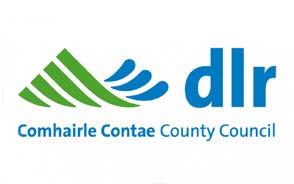Charrette Report









Three groups of students were invited to engage in the IADT charrette on the creative economy in Dún Laoghaire (DL) for a week from 26th to 30th September 2022.

Students were divided into two teams:
1. Pathways: envisage and propose opportunities to build a sustainable and equitable creative economy with IADT and Dún Laoghaire-Rathdown County Council.

2. Horizons: visions of a Dún Laoghaire creative economy in 2047.


Dún Laoghaire County Council (DLR Co Co) staff collaborated with students, shared their insights, and acted as advisors and support for them.
In addition, members of the Dún Laoghaire business network, DLR Co Co, IADT alumni and an IADT Media Cube representative also attended the interdisciplinary session on day four to collaborate with students.

Finally, on the last day, students presented their findings and insights to the IADT faculty and Dún Laoghaire-Rathdown County Council staff.
This document includes a breakdown of the activities, insights and ideas and a summary of the creative solutions generated during the process.
Images above - charrette locations from top to bottom: Dún Laoghaire Town Hall, dlr Lexicon, IADT
A Design Charrette is an intensive, hands-on workshop that brings people from different disciplines and backgrounds together with members of the community to explore design options for a particular area.
Charrette - design thinking methodologies are used to gain insights, provide a forum for exchanging ideas and explore alternative approaches
Towards a Creative Dún Laoghaire
26th September
Location: IADT
The first meeting of the students was to introduce the subject and meet their teams.
The project goal was to explore new ways to deepen relationships between IADT and Dún Laoghaire Rathdown County Council and discover ways to enable IADT graduates and other creatives to stay working in Dún Laoghaire.
Project Mission: ‘To collectively support and develop a vibrant, inclusive and sustainable creative economy in Dún Laoghaire.’
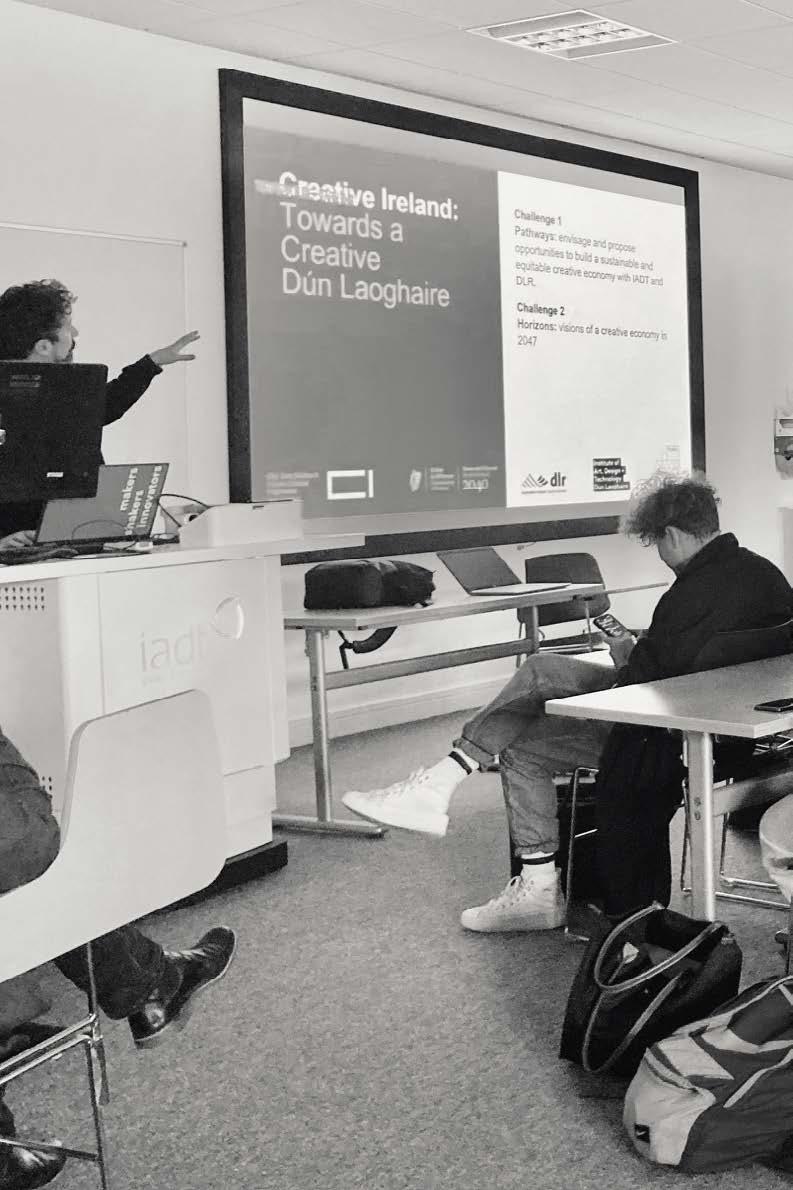 Students from different courses met to collaborate using design thinking methodology
Workshop Launch
IMAGE: Clyde Doyle, Lecturer, Researcher, Co-Programme Chair, PDL Founder during the Charette Launch
Students from different courses met to collaborate using design thinking methodology
Workshop Launch
IMAGE: Clyde Doyle, Lecturer, Researcher, Co-Programme Chair, PDL Founder during the Charette Launch


In the morning, there was a joyful, fun atmosphere. Although the students were shy at first, they quickly relaxed and began laughing and joking by mid-morning. Presentations on creativity went in unexpected directions when one team did not create a logo. As a conscious effort to explain what creativity means to them and how to embrace it, they presented a blank page. The team agreed that creativity is inherent to everything, so there is no limit to its application. It can’t be fully described or framed in a logo since it embraces the limits of what is limitless. Everyone in the room stopped for a moment. As a result, a topic for future discussion was created.
Conversations about creativity and the creative economy were repeated throughout the week and allowed for reflection on the meaning of work, quality of life, and the future.
Students provided short feedback about the morning: Among the things they learned were:
• Cooperate to develop ideas
• The brainstorming process
• A collaborative effort
• The importance of communicating with the client and listening to their needs
12.00 pm
For lunch, we will set up the following task:
Each student received a location in Dún Laoghaire and three random words. By observing and using the words provided, they were to create a short story about DL. During this task, students observed and discussed various parts of Dún Laoghaire, such as the harbour, the Marine Museum, and People’s Park.
12.30 Lunch
13.30 Visit from Dún Laoghaire-Rathdown County Council: Ciara King, Carolyn Brown, Ursula O’Connor and Róisín Cronin.
Students were able to hear directly from the county council staff about the tasks and challenges they face, and how they support the creative economy from the DLR Co Co perspectives. The students presented short stories that they had created while walking about Dún Laoghaire to the group. This added a fun dimension to the conversation as they shared their energy and creative views of the world. Those were the first of several conversations between students and county council staff that would take place that week as part of a two-way collaboration. Several questions focused on grants and schemes, as well as access to various materials, such as film equipment, for animation students, who sometimes feel undervalued as artists. The students also discussed their place in Dún Laoghaire and possible job opportunities.
3.00
Several aspects of the creative economy had to be considered by students during their research:
• Socio-economic
• Sustainability
• Environmental
• Cultural
• Technological
• Student / Graduates
As a result of their research, we brainstormed and created several clusters to reflect on and discuss each of the aspects.

“I found the mix of different course backgrounds and ways of thinking were very beneficial to our problem-solving.”.


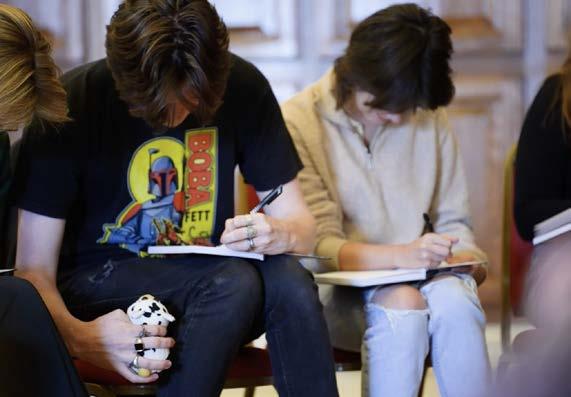





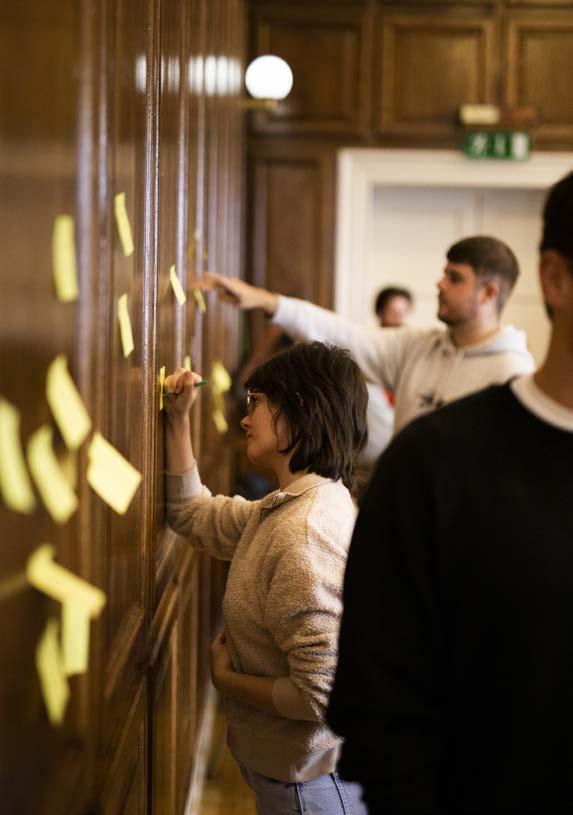


• What can be done to overcome the barriers facing artists with lower incomes?
• Is it possible to access grants and events that do not require an entrance fee?
(There is usually a fee associated with most artist events, but this can be a barrier for an upcoming artist)
• Making more creative spaces available to the public by repurposing more space (Lexicon is an excellent example)
• Facilitators of arts/culture need to be widely accessible
• There is a need for more affordable spaces to sell art and crafts - like Christmas markets or other types of markets
• People should be given more time to engage in creativity so they can benefit from it
o Macroeconomics focuses on the overall economy - local thinking is lacking
o A growing creative economy benefits the local economy
• Pedestrian-friendly areas
• The number of street bins should be increased and mixed recycling bins should be available
• Plant pots and greenhouses in public places
• Educate people about water conservation
• Technology can be used to leapfrog unsustainable practices and move to greener ones
• Improvements needed in housing and public transportation
• It is important for music, film, and art programmes to advertise at nearby colleges
• Physical spaces for young people to collaborate and work, as well as “hang out”
• A variety of activities (other than a pub)
• A stronger relationship between institutions/schools and the council is needed, as well as more workshops and projects that are done together
• Infrastructure for interactive experiences
• More grants for students/graduates to showcase their work
• Provide students with information about grant opportunities
• We need and want free spaces for artists
• A greater value should be placed on animation (currently, it’s not considered “real movies for adults” in Irish culture, so more original animation should be funded)
• Make events and other projects culturally relevant
• Old Library - heritage, vacant space to be repurposed
• Create V.R. tours and experiences in DL, such as exploring Dún Laoghaire heritage and Victorian parks
• DL has a heritage that needs to be preserved, shown to the community and widely accessible
• Participate in Irish cultural traditions as well as those of other cultures, and be open to the cultures of the place you live
• Access to a computer lab (similar to the ones in Lexicon, but bigger and more contained)
• Public hotspots - a connected environment
• Equipment available for public rental
• Events/jobs/grants/social media promotions
• Gym available with equipment
• An open discussion of artificial intelligence abo the arts
• There should be more art competitions
• Art galleries and science museums available to the public

“Using creative thinking to solve serious problems allowed for more open-minded solutions.”
Wednesday, 28th September dlr Lexicon, Dún
Wednesdays goal was to reflect on the imagined future, first in our personal context, then within the team and organisations we are part of, and finally in a broader Dún Laoghaire context.
We wanted to let participants look at Dún Laoghaire from their point of view, observe, and notice both the gaps and opportunities.
Students were encouraged to look at the area through the lens of the long-term future, to imagine and envision how things might exist rather than focus on small short-term fixes.
As the morning progressed, for practical reasons we decided to merge the two teams into one.
10.00 –Welcome, warm-up exercise
10.20 – Individual reflection: my future, my talents.
Work in pairs – What talents can I bring to the group?
10.40 Creating team charter – sharing our strengths.
Break
11.00 Future me – Reflection on the future, personal timeline into the future, students calculated that their life affects people over 250 years, deep future reflection.
Christopher is a faculty member of George Brown College, School of Design, Toronto and Founder of the Department of Unusual Certainties.
12.00 Presentation
Introduction to future thinking, design speculation and worldbuilding. Students reflected on both their personal goals and the goals of their team
1. Continual learning and development
2. The thought process (expanding selfawareness, inclusivity, freedom of expression, and rational prediction)
3. Adapting to a world in constant change
12.30 – 14.00 - Lunch.
Observation of Dún Laoghaire – mapping exercise
14.00 Ideation – based on observation and knowledge of Dún Laoghaire gained over the last two days.
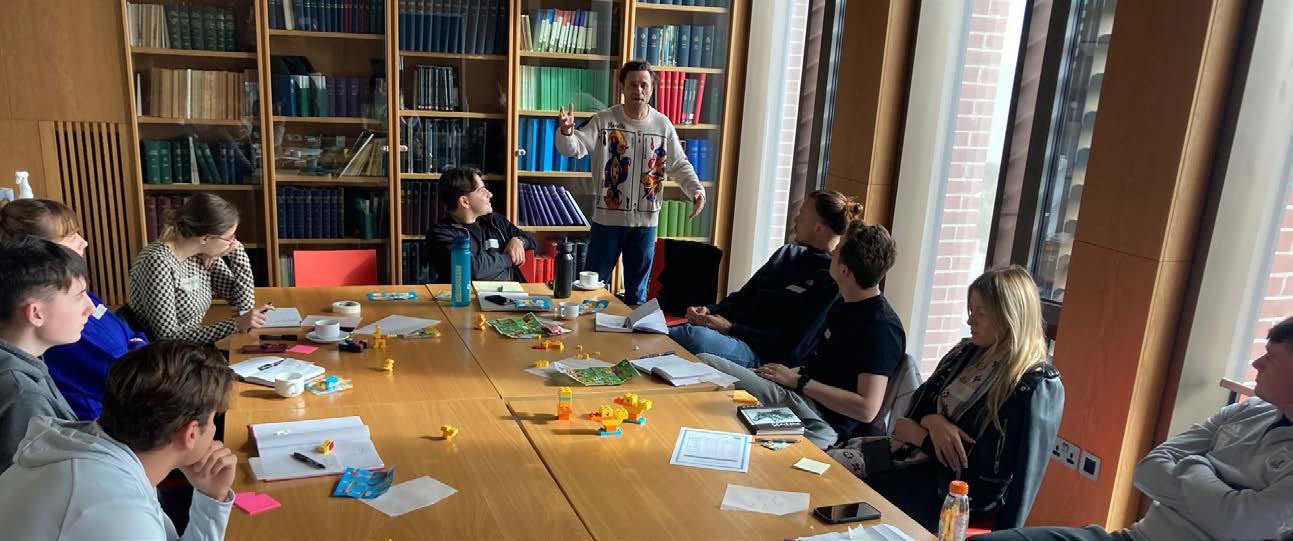
“The most reliable way to predict the future is to invent it.”11.30 Christopher Pandolfi – Guest Lecturer discussion about the circular economy, activism and sustainability. Abraham Lincoln


“The process involved, thinking on the spot and contributing.”
IADT student
The development of ideas that embrace and envision a vibrant creative economy in Dún Laoghaire
Ideation

• The transformation of unused public spaces into amateur art galleries
• The absence of bureaucracy,
• Space indoors or outdoors
• Honours the town’s history and culture
• Develop a strong connection with IADT to encourage students to participate as primary contributors
• To help artists grow in the area, set up an area where BYOA (bring your own art) is welcome
• Obtain funding for the above idea
• To attract people to DL, start an art fair
• Repurpose the old library / or other suitable space
• As a stepping stone to more permanent housing, it could be a place to house Ukrainian refugees
• The accommodation could also be used by students
• Repurposed buildings should be subject to rent caps
• Increase the living space by building into the water
• (Olympic) Stadium near Forty Foot
• Swimming pool in the sea
• Red bull sea diving at Bullock Harbour
• Water polo tournament & swimming competition in Forty Foot
• Community gyms
• Larger park area
• Playground improvements
• Bloomfield area - revamped for kids and skate park
• A community based on art, food, and talent
• More free water fountains should be built
• Convert run-down pubs into social settings, such as discos, rollerblading discos, etc.
• A greater number of public bins
• Get people to attend festivals around food and art without alcohol
• Events like outdoor movies could be added
• Small businesses and markets to cater these events
• Create activities within the festival/event that encourage people to socialise and bond without alcohol
• Replace the shopping centre with a skate park
• The main street needs to be made pedestrian-friendly
• DL is more cycle/walk friendly
• New paths along the seafront will have loyalty and reward systems for cyclists and pedestrians
• There should be more parking near the main street
• Focus on making bikes more accessible throughout the DLR
• Promote more usage of public transport and cycling for shorter commutes
• Me+go
• More roads around DL to reduce traffic / 2-way traffic / push a sea wall further to create a space for a wider lane
• The implementation of scooters where it will cost 25 cents per minute (short-term)
• Adverts on scooters (ideally for DL events) could help fund their cost.
• Dublin needs more public scooters and stations to return them
• Identify ways to sustain sea life in the area
• Understanding what sea life does for the planet and creating a way to experience it
• The goal should be to make all boats and sea harbour buildings green and to incentivise the process
• To combat rising sea levels, building more into the water and using the newfound space for leisure activities, skateboarding, etc., will boost community expression.
• A larger pier to accommodate more people
• Pier community fundraiser
• A larger pier would allow more boats to dock, resulting in a significant increase in revenue
• More student workshops with IADT students and graduates
• Residents of DL can participate and the results will be displayed around the town
• Promote workshops in the college, not just via email
• Students teach older adults about social media in workshops
IMAGES ABOVE: students notes and mind maps generated during the workshop
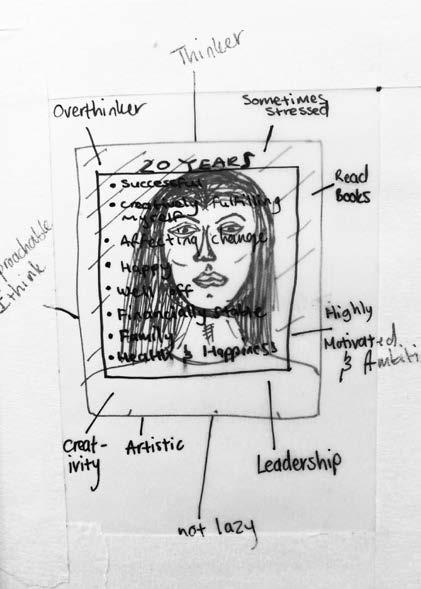

As a result of this activity, students created a map and discussed where they had been. There were a few areas that students decided to redesign, for example:
• Shopping Centre – redeveloped with greenery, a fountain, and exhibition space (similar to exhibits in the metro without windows).
• A museum of amateur art is located on the main street in Dún Laoghaire
• Using the old library as a public space for socialising, workshops, and arts and crafts
• Student-led night lessons
• There is a permanent market on the west pier with a variety of performances, food and drink.
• An extension of one of the Dún Laoghaire piers
Students want more places where they can socialise (without alcohol), and more accessible and widely available performances, such as open movie night, interactive water fountain, permanent market on the pier, and various street and art markets and festivals around food and art.
Their view is that recreational activities around sport are in high demand; skate parks were mentioned several times, as were water sports, such as swimming competitions at Forty Foot, Red Bull sea diving at Bullock Harbour, as well as simple activities like community gyms that would benefit the students.
It will be possible for the community to come together through a variety of activities. There could be activities such as art making and crafts, night lessons, or sharing knowledge, such as drawing classes for students, or classes on social media for older adults.
The idea of the Museum of Amateur Art, an area for BYOA (bring your own art) or Start an Art Fair, came from students needing to find affordable space to make their art available for display and purchase.
Advertising around events was mentioned as something that not only should be done by email, but they would like to see larger advert displays around activities available in Dún Laoghaire.
In conclusion, students would like to see more information and recreation related to the theme of the sea and DL’s heritage.
Embracing Dún Laoghaire’s heritage could be done in an attractive, modern way. The students expressed a desire to know more about Dún Laoghaire, but they thought that the information should be presented in an attractive, playful manner, possibly with virtual reality and other new technologies.
As far as the sea is concerned – apart from some sport recreation activities, students suggested that information about it be made widely visible; this could include extending and promoting marine life, interactive displays of sea creatures, and posters and banners that depict sea life throughout the area, creating a local attraction.
The mapping exercise involved students wandering around the town discussing gaps and opportunities. Some of them took their conversations around the need for space for art to another level, drawing up concepts for repurposing various units. For example, they turned an old shopping centre into an exhibition space with greenery and a fountain, defining empty space as an opportunity and creative space. Also discussed was repurposing a car park next to the shopping centre into a park with trees and greenery.
Here are a few highlights of the findings:
• Creative workshops, arts & crafts making, night classes, and creative learning spaces
• A space that allows students, young artists, and amateur artists to create and sell art at an affordable price without complicated bureaucracy, and that is widely accessible to the public.
• Students are keen to experience knowledge sharing, for example, by providing social media workshops to older people, but they are equally eager to attend book readings and storytelling sessions.
The cost of housing is a barrier; students talked about the need for affordable housing for them and temporary housing for Ukrainian refugees. Several students suggested repurposing various units for accommodation and capping rents.
A topic of discussion included transportation within and around Dún Laoghaire as well as the need for pedestrianisation. Students discussed bicycle lanes and the need for more affordable and widely available bike rentals. Among the ideas was the introduction of scooters as a potential mode of transportation paid for by advertising (with advertising revenue coming from recreational events). It is also important for students to see a significant reduction in the cost of public transportation.
Green initiatives were discussed in each conversation and a strong emphasis was placed on the subject. Students place a high value on sustainability. As a result, they would like to see more green initiatives, incentivise green businesses, and support pedestrianisation as a means of reducing the carbon footprint.
In their opinion, sustainability should also be part of recreational activities. It might be possible to open a conversation about climate change by displaying sea life or the benefits of the sea. In this regard, it might serve as a catalyst for reflection and reinforce positive behavioural changes.
3.00
of looking at the big picture was introduced to students.
It moved beyond practical conversations about Dún Laoghaire and its possibilities, to bring another dimension to the students. In addition to learning about long-term thinking, participants were introduced to future thinking, future literacy, and concepts of signals of change.



 IMAGES - observations, students notes and maps generated in the process
Presentation - Peter Evers Programme Chair & Lecturer in Graphic Design IADT, PDL Founder Systems thinking and the importance
IMAGES - observations, students notes and maps generated in the process
Presentation - Peter Evers Programme Chair & Lecturer in Graphic Design IADT, PDL Founder Systems thinking and the importance

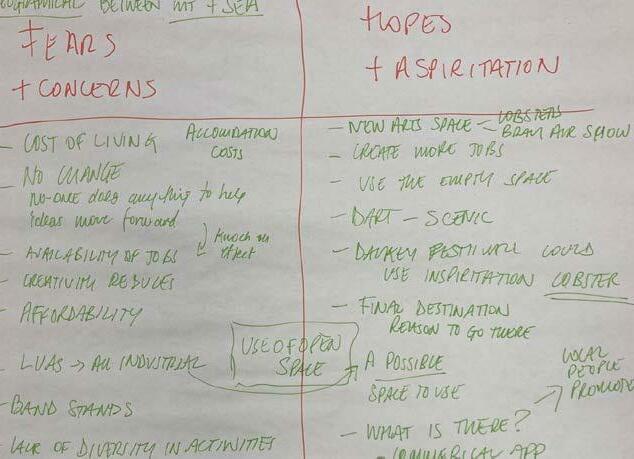





An interdisciplinary design session was scheduled for Thursday morning. Students were joined by guests from Dún Laoghaire-Rathdown County Council, DL business people and a local artist.
After a quick warm-up exercise - which introduced those who joined us to design thinking methodology - the group started exploring three questions, including:
What does the creative economy mean to you?
Creative economies were identified in a variety of ways, including:
• Critical: Mass/hub of creative thinkers
• Accessible talent pools for recruiting
• A lifelong learning experience
• Systematic improvement of education
• Reducing the use of non-sustainable products and practices
• Creating a more sustainable lifestyle
• Creating a more sustainable society through new ideas
• Government-funded solar panels
• Different forms of energy
• A blend of technology and art, AR and VR
• Spaces that are accessible and appropriate
• Enhancing accessibility of art by utilising technological advancements
• Promoting job opportunities for graduates in the creative industry
• Connectivity that is fast and reliable
• Access to software/hardware
• Explore art through A.R. in a fun and enjoyable way
• Transport system improvement
• Use creative ideas and practices to leverage business opportunities
• A culturally inclusive approach
• Increase younger demographics
What are your fears, concerns, hopes and aspirations regarding the creative economy of DL.
Summary of findings, interdisciplinary group
Fears & Concerns:
• Living costs are too high, Availability and affordability
• The cost of housing is too high for students
• Nothing is done to help ideas move forward - there is no change
What does a creative city mean to you?
Group worked on several examples showcasing creative cities; here is some of the chosen examples:
New York: Funding supports for training / experiential programmes
Cape Town: Evening activities, Easy access, Public art
London: Permanent markets, Evening activities in markets, Craft beer / local products, Critical mass of businesses in creative space
Belfast: Artist’s studios and art spaces
Berlin: Art spaces, urban design; Homeless collect plastic bottles and beer bottles and trade them for money in newsagents; Funds artists and encourages vacation for artists every year; Berlin Art Week; Openness of local authority to host/promote cultural / creative activities
Budapest: Good night clubs; Cleaning up after a night out
Amsterdam: Small retail businesses; leveraging of creative past to inform the vision of a creative futuree, creative from a standpoint; boats, electric scooters, bikes
San Antonio: Tech, Interactive water features
Manchester: Redeveloped public/private partnerships to create spaces
Austin: Previously derelict spaces given to creative pursuits
Waterford: Murals
Venice: Biennale
During the session, it was suggested that we need to look beyond Dún Laoghaire town and consider DL as a larger creative county, geographically located between the sea and mountains.
• The availability of jobs has a knock-on effect on the previous point
• Reduced creativity
• An unused part of our heritage is disappearing - band stands
• Activities are not diverse enough
• The lack of options for various sports (such as water sports)
• Use of water space (became a concern and immediate aspiration)
• Age demographic in DLR Co Co - injection of youth is needed
• Space is being taken over and eliminated by multinational corporations & by new housing developments
• Night-time economy, Antisocial behaviours at night
• Accessibility for people with disabilities
• Diversity is lacking
Aspirations:
• A new art space for creatives
• Events and galleries related to art
• Reopening of IADT in Dún Laoghaire
• A better interaction between all stakeholders
• There is inspiration to be found in Dalkey Festival, Lobster Festival, and Bray Art Show.
• Add more jobs to the economy
• Make use of the empty spaces
• DART – scenic route
• DL as the final destination
• The use of open spaces
• Local people – promotion/communication device amongst the community (opportunity to create a directory, commercial app)
• Harbour use in some way, including the main street
• Grant schemes
• Better nightlife
• DL as an evening destination
• DL as a place for families/family recreation
• Grants and schemes information
• Opportunities for low-income artists to overcome barriers
A list of hopes, aspirations, fears, and concerns was created as part of the morning session, creating alignment and understanding between students and those who live and work in Dún Laoghaire-Rathdown.
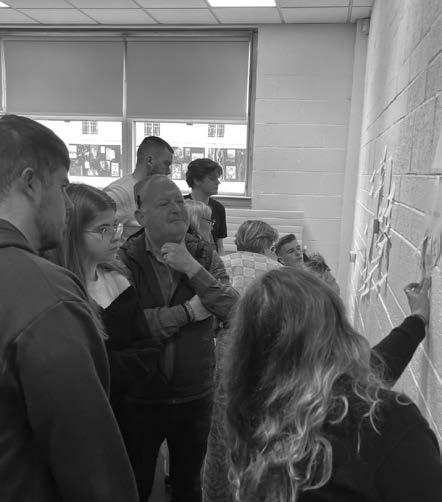
Having heard the concerns and needs of both groups, the next step was to identify synergies and opportunities between earlier fears, concerns, hopes, and aspirations.

The night-time economy, while a concern due to its lack of originality and antisocial behaviour, could also be an opportunity for Dún Laoghaire.
Public transport was discussed, and the DART was seen as an aspiration because of its picturesque scenery, while the LUAS was seen as a concern because of its industrial feel. Like the scenery in DART, public transport could become a means of displaying creativity and art.
The concern named “things will never change” involved students clustering their concerns into four main groups and agreeing on main pillars:
Transport
Communication was agreed upon as an overarching cluster connecting all above
As a result of this exercise, students were able to create mental links between various pillars and opened their minds to new possibilities.
As a next step, students were asked to identify and observe signals of change (a concept they had been previously introduced to).
Signals included smart watches being more common, holograms, virtual reality, mobile phones, electric cars, renewable energy, more people relying on tech for jobs, and possibly robots to replace workers.
Finally, we asked the group to create ‘snapshots’ of everyday life from 2047 in which fears have been resolved and hopes and dreams had been realised.
To leap forward into the future, the signals listed above were used as prompts.
The students enjoyed this exercise and came up with a variety of creative ideas. During this stage, we encouraged creativity and imagination to run wild. During the next phase, we wanted to go backwards and identify more plausible options. However, we allowed and encouraged even the most creative and bold ideas initially.
• Projects with constant public funding
• Band stands showcasing the heritage of DL and concerts by local bands
• To reduce CO2 emissions, use festivals to purchase portable houses, solar panels, and plant more trees
• 24/7 Festivals
• Restaurants / pubs / social areas
• The simultaneous celebration of two festivals
• Festival of Sleepy Beddybye
• Providing food through vending machines
• There is less waste of space - it can be used for social events or businesses
• There will be changes to the road network
• Public transportation is free
• Global Art Festival
• A festival dedicated to film and theatre
• Presentation- start with: how did we get here? (module of transport)
• Life of Regiwald (9?), time machine as a module of transport
• Electric scooters
• Providing grants to students
• Location contributes to tourism revenue
• Affordable Housing
• The festival proceeds will be used to lower housing costs
• The return of affordable social housing
• All buildings are fully accessible to people with disabilities
• Job creation is a result of festivals
• Floating restaurants
• A greater number of boathouses
• An abundance of renewable energy (= total energy)
• Zero-emission digital content servers to slow the tide

• The good-vibes electricity generator
• Use festivals to BUY portable houses, and solar panels and plant more trees to reduce CO2
• Electric transport – cars and scooters
• “IADT, WIFI is REAL.”
• Communication device for community members
As students reflected on their vision, they realised that 2047 is not that different or that far away.
After reflecting on the two main charrette themes, they decided to present insights in one presentation. They simply moved the timeline from 2047 to 2022 to their Dún Laoghaire of the future, where their creative aspirations and needs were resolved by creativity.

This reflection inspired students to create a script based on the journey of the invented character - Reginald - who travelled in time (via wifi).

“This collective – a combination of business, design, and animation students – has led to a wide range of ideas, which was extremely beneficial in coming up with interesting options for Dún Laoghaire’s future, and a pretty interesting way to present those ideas (Reginald)”.

1. Hello, the Charrette we took part in was Pathways and Horizons. Pathways aimed to understand DLR Co Co’s current creative economy and what can immediately be done to improve it. Horizons aim to take these ideas further and envision what Dún Laoghaire’s creative economy would look like in the year 2047. We decided to combine our presentations for a clearer and more cohesive picture of what this future would look like, and what steps we could take today to work towards it.
Now without further ado, we take you to that very year. The sun is shining on a futuristic Dún Laoghaire in 2047.
AND NOW… I INTRODUCE YOU ALL TO REGINALD
Reginald is a DLR resident in our futuristic vision. He’s a regular guy just like you and me, some of his interests include
(CHANGE SLIDE) clocks and clarinets.
Today is a big day for our friend Reginald as he is planning to go to a festival. He wakes up in his nice, affordable apartment and goes through his morning routine (regular stuff, such as showering and cleaning his teeth with the Dental Orb). He’s almost ready to head out to his destination but wants to double check when and where everything is happening, so he speaks aloud ‘’HUB, APPEAR!!’’
(CHANGE SLIDE) The DL Creative Communication Hub manifests in front of him as an interactive hologram. All the information about events and opportunities to do with the arts is displayed and Reginald gets going confidently.
2. To get there, Reginald decides to hop on the D’art.
(CHANGE SLIDE) Formerly called the dart the D’art is a free-access intercity train with beautiful murals adorning all Dún Laoghaire stations made by commissioning local artists. Reginald appreciates the decor and sits on the dart that is NEVER late.
(CHANGE SLIDE) As Reginald looks peacefully out the window, he passes the many tidal energy generators on the DL coast that power the town.
Once he arrives, he hops on a handy-dandy public hover scooter for further travel convenience.
Finally, Reginald makes it to his favourite of the many Dún Laoghaire festivals, the wellbeloved Time Machine Festival :)
(CHANGE SLIDE)
We see beautiful ornate stairs and wheelchairaccessible ramps leading to a bustling festival space.
Passionate time-machine engineers are showing off their new designs while artists and craftspeople are selling their timeinspired work. (We also solved time travel in this charrette but that isn’t the point of this presentation, so we don’t have to tell you.)
(CHANGE SLIDE) Reginald catches up with his friends who are discussing past festivals that occurred this month such as Reginald’s second favourite: the clarinet festival, the sleepy beddy-bye festival, the festival and more!
Some of his friends mention how the grants they recently applied to have been approved, and how helpful it is to receive them as IADT graduates so they can further take part in the festivals and the community
(CHANGE SLIDE) Finally, Reginald arrives at his favourite place in the festival, People’s Park. Built upon the historic bandstand is this year’s freely accessible time machine. Reginald is a sentimental person and decides to take a trip down memory lane, he hops in and sets the course for the year 2035.
(CHANGE SLIDE) WOOSH
(CHANGE SLIDE) Reginald watches his WiFi go from 800G to zero as the time machine arrives in the past. He gets out and strolls through Dún Laoghaire, taking note of how different everything looks.
(CHANGE SLIDE) He sees the underwater tunnel between DL and Europe still under construction,(
CHANGE SLIDE) tidal energy was just being implemented, (CHANGE SLIDE) the Good Vibes Generator(TM) hasn’t even been invented yet. Reginald remembers this as
the year he bought his first clarinet, what a beautiful year. :)
Still curious, Reginald decides to then take the time machine to the year 2023. (CHANGE SLIDE) It takes longer to arrive this year as it’s further away. (Classic time travel rules) but Reginald persists.
(CHANGE SLIDE)
He was too young to remember this year and is surprised to see that a lot of things seemed to be set in place this year.
(CHANGE SLIDE) The creative arts community workshop area was still under construction, soon to be an indoor area for students and artists alike to relax, communicate, and create. The dart station was receiving its murals for the first time. The Creative Hub was a digital V.R. directory instead of an instantlysummonable hologram. Reginald was grateful to this year for this thing it had set into motion ‘’Thank you, year!’’ He exclaimed. The year said nothing back.
Satisfied with his journey, Reginald took one final look at the beginnings of the DL of 2047, thinking about how far things have come thanks to the great work done developing the economy. He hopped back into his time machine to go home. (CHANGE SLIDE)
What have we learned from this charrette?
The most important aspect of this charrette was teamwork. All three days revolved around not only coming up with ideas but doing that as a part of a team. We did various exercises, like creating hats for clients, or coming up with the worst idea for a cereal box to learn creative design processes.
Walking around Dún Laoghaire in groups and mapping the town was a useful way to get to know the area and identify the problems, learning to tackle problems as a collective.
This collective – a combination of business, design, and animation students – has led to a wide range of ideas, which was extremely beneficial in coming up with interesting options for Dún Laoghaire’s future, and a pretty interesting way to present those ideas (Reginald).
The most important aspect of this charrette was teamwork. All three days revolved around not only coming up with ideas but doing that as a part of a team.
We did various exercises, like creating hats for clients, or coming up with the worst idea for a cereal box to learn creative design processes.
options for Dún Laoghaire’s future, and a pretty interesting way to present those ideas (Reginald).
Our key insights for Dún Laoghaire revolve mostly around the possibilities that 2047 offers.
At the same time, these goals should be reasonably thought out by setting milestones throughout.
After all, Rome wasn’t built in a day. Questions that remain, problems that haven’t been resolved
Our key insights for Dún Laoghaire revolve mostly around the possibilities that 2047 offers.
Walking around Dún Laoghaire in groups and mapping the town was a useful way to get to know the area and identify the problems, learning to tackle problems as a collective.
This collective – a combination of business, design, and animation students – has led to a wide range of ideas, which was extremely beneficial in coming up with interesting
The fact that we looked so far into the future made us see that no plan is truly short-term, it will eventually influence the far future. This is inspiring but worrying as well. We can’t look over the fact that today’s problems can greatly affect the future of Dún Laoghaire if they are left unresolved. Problems like expensive accommodation, high living costs, and gentrification could stop any advancement Dún Laoghaire is capable of.
However, change doesn’t happen overnight. Our talks with Chris, the County Council staff and various professionals based in Dún Laoghaire showed that genuine goals must be far-reaching if we want to find a solution.
During our third day of the charrette, while proposing our ideal future for Dún Laoghaire, we were asked a question - why can’t we just have all of that now? Overall, it is because of problems and barriers that are out of our immediate reach. Problems like people’s fear of change, bureaucracy, resources and money can create barriers that could, and very much will, hinder the future of Dún Laoghaire.
We, unfortunately, had a limited amount of time to go over these problems in detail, but we are hopeful that this project will at least inspire those who have more resources and time to tackle some of these barriers.

There is a clear need among emerging creatives and students for space to be, work, and create, but most importantly, to share their creativity, art, and knowledge.
It is important to students and young creatives to be able to display their art in public, but they can only do so if they have access to and affordability of a space in which to do so. As well as being a host for various types of creative activities, exhibitions and galleries would bring the public to the town and support its vibrancy as well as benefit other businesses.
Creative industries go beyond traditional art; DL could consider how to bring innovative thinkers and innovators, how to create space for various creative production companies, and how to foster creative conditions and places for creative businesses to thrive.
In the workshop, many suggestions were made, all under one umbrella: collaborative work is only possible when certain conditions are met. Long-term strategy and vision for the DL could include identifying opportunities and creating several spaces for students and emerging artists.

DL can become a cultural destination on a larger scale if creative space is properly utilised.
Accommodation costs are on the list of one of the main barriers to be addressed. It’s part of the wide systemic problem, however, naming the issue is a must, and attempts need to be made to help to make the accommodation more accessible to students and young creatives so they become part of the fabric of DL.
Based on the overall findings of the workshop, the following trends emerged:
The lack of simple procedures and processes were named as one of the main obstacles for creatives to utilise their talents and stay within the area. This leads to frustration, loss of energy and demotivation as well as constraining innovation. There are ways in which this could be addressed.
Students would like more information about the supports available in an accessible way, as part of a wider communications strategy for ‘Towards a Creative Dún Laoghaire‘.

There is a need for creative activities and opportunities for recreation within DL town and county. Some could involve art and craft-making, and others could include sports. Open and empty spaces should be utilised. Sea location and proximity to the water are significant elements on which recreation could be based, as well as DL’s heritage. The bottom line is that there is a hunger and unsatisfied need for places to meet – outside pubs, which do not involve alcohol but evoke various creative aspects to bring its sociable aspect.
Learning could be combined with recreation, done innovatively, and all the sustainable practices could and should be embraced.
Further research is required to identify and embrace DL as a cultural, creative, recreational destination for a wider demographic including students and families. In this case, design thinking methodologies and workshops with the public could be beneficial in identifying strategic locations and choosing the right course of action.
Students’ presentations and thinking evolved around festivals. In their imaginary DL, they envisioned a place where festivals are happening 24/7, on every corner. In reality, several festivals have taken place over the years in Dún Laoghaire yet for some unknown reason some ceased to continue and the reason for this was not clear to the students.

However, looking at examples of creative cities around the world many of them share one common thing: they run a major transformative event in town, which helps to refine their cultural position on a national or international scale, and helps to support the local economy.
Further research is needed to analyse the non-continuation of festivals within DL and identify what kind of event could bring this transformative aspect to reinvigorate the creative economy and position Dún Laoghaire as a global creative centre.
Many conversations during the workshop evolved around DL’s heritage and ways to embrace it innovatively. Students give great examples of Band Stands, which could be used for concerts and festivals. Other heritage elements of DL could also be made more exciting and accessible via new technologies, such as A.R. or V.R.
Students would like to see more places open past 6 pm; they do not go there, as they know everything is closed.
On the other hand, demand drives the economy, so businesses knowing that students are in town could see a more expansive offering outside of pubs. By embracing other aspects mentioned above, night-time economy could have a positive impact.
Students and young creatives indicated their need for a more vibrant and safe night-time economy, which was listed as an aspiration but also as a fear – due to current antisocial behaviours.
The subject of gentrification came up as a topic a few times during the workshop. We didn’t dive deep into the source of the issue, but it needs further research and analysis.
Sustainable practices form one of the main pillars of the modern creative economy, and one cannot exist without another. To achieve long-term sustainability, it is necessary to strive for a green economy and come up with solutions to address issues. This will require innovations across the board and creativity in all fields. Creativity and sustainability are closely linked.
The U.N.’s Agenda 2030, with its 17 SDGs sets out the economic, social and environmental dimensions of a sustainable world. This requires concerted efforts towards building an inclusive and resilient future for the planet. Innovation, the business of ideas, is increasingly seen as the key to future societal prosperity and business success. Any new technology or process that does not create a positive change in people’s lives does and should not qualify as innovation.
The creative economy can be environmentally sustainable; students identified their clear preferences for sustainability criteria, for example, in music festivals and other cultural activities. In the future, for example, the organisers will have to start applying various sustainability criteria during the creative activities/festivals to attract visitors and generate more income from such events to ensure environmental safety.
“I found the mix of different course backgrounds and ways of thinking were very beneficial to our problemsolving. Using creative thinking to solve serious problems allowed for more open-minded solutions.”
It was nice to chat to the County Council staff who you felt like could make a difference, with collaborative thinking between both the decision-makers and the people who these changes would affect.”
“I found the mix of different course backgrounds and ways of thinking were very beneficial to our problem-solving.”
“We used practical thinking, putting ourselves in a position where we could implement change in Dún Laoghaire, by walking around and envisioning possible changes around the town.”
“I will approach problemsolving with a more open mind to creative solutions down the line and will be more open to trying more things that may fail without fear of failure.”
“
“We empathised and tried to look at the problem from the perspective of the people who were leaving Dún Laoghaire.”ABOVE: Students’ feedback and learnings from the charrette
There is a need to bring a younger voice to the towns decision-making. Students remarked a lack of diversity within the DLR Co Co.

During the research, we looked at several precedents; for example, the development of a ‘Creative Town Dept.’ led by artists an students, which would help to diversify the environment and open-up conversations about creativity on a different scale.
As a process of the workshop, we learned that enhanced perception, embracing complexity and a new sense of agency could evoke activism and bring numerous ideas to the table.
In fact, in one of the sessions, the group suggested more workshops as an idea to develop a creative economy. This indicated individuals’ need for highly collaborative spaces and environments, to open up possibilities, create connections, partnerships and positive working relationships.

“The fact that we looked so far into the future made us see that no plan is truly short-term, it will eventually influence the far future.”

Note: essay added to the findings to record students point of view and insights
There is no denying that the rising cost of living in Dublin has been an increasingly alarming issue over the past several years. This is particularly evident in South Dublin, anecdotally ‘the posh half of Dublin’, as students are still scrambling to find accommodation spots that seemingly won’t break the bank while also (though this is painfully subjective given the circumstances) being within range of campus. That isn’t to mention the Hunger Games-style levels of competition for housing, not only against other IADT students but students from neighbouring colleges such as UCD and DIT. We are all privy to these issues and the government’s negligence and corruption that has exacerbated these problems.
What we need to understand is that the only way to improve Dún Laoghaire as a creative space isn’t to throw up a few exhibitions and grants at creatives under the guise of aiding artists, but to make Dublin liveable and accessible so that we can all appreciate a town that isn’t gentrified; one that values its identity over corporatism.
We need to foster creatives in their infancy, so they don’t become disenchanted and leave their creative fields in pursuit of what they feel is necessary to survive; in a world where people already disregard the value of artists’ work, both from a monetary and cultural standpoint.
Not only do we need to look out for creatives but simply young people in general. Many young Irish people, particularly in Dublin, feel as though they are being pushed out of the city. We are being placed under a
microscope where we are reduced to whiny, entitled, delusional kids who are unwilling to adapt to our environment when we are yearning for, not only a city but a country that can finally exercise its potential.
Children stop being our future when they are forced to find a home elsewhere.
Dún Laoghaire, and Dublin as a whole, need to establish indoor spaces where young people can mobilise outside of campus, free of charge. If we achieve this, it will make it significantly easier for young creatives to get together and organise events and branch into artistic initiatives which will encourage collaborative ventures and inspire new work across all media.
We need to introduce more cultural events to preserve Irish culture in our modern, urbanised society as well as to shine a light on the new cultures and identities that have migrated to Ireland in the last few decades. We need to become more self-sufficient and generate employment that isn’t centred around tourism.
Dún Laoghaire, though very scenic, shouldn’t become a tourist trap as this will displace local people and further rise living costs.
Introducing free public transport is a must. While there are services such as leap cards put in place to reduce cost, particularly for
students, they significantly rack up if you have an adult leap card. On top of this, we ought to introduce 24/7 modes of transport to ensure that young people can safely and inexpensively return home at night. The city council should also encourage cycling and increase the availability of public bikes.
This one, as we all know, is the hot topic of discussion when it comes to living in Dublin, especially on the South Side. With scarce availability, short leases and soaring costs, the housing crisis has had a chokehold on Dublin for years. With the rent for a one-bedroom inter-city apartment statistically averaging 1,896.35 euros (and the same apartment averaging 1,639.20 outside of the city centre) rent accounts for roughly 40% of the average Dubliner’s expenditure. These egregious costs not only alienate young creatives and college students but above all, working-class people.
This cycles back to my point about gentrification with the issue growing more severe as the Irish government prioritises the construction of hotels over public housing and student accommodation.
We as students and artists have no choice but to leave. We need nationalised accommodations that are subsidised by the government, so we don’t have to rely on private property owners and landlords.

As I’ve already mentioned, I am a big advocate for encouraging the use of public transport which is one obvious means of keeping cars off the road and promoting sustainability. I also believe that we should utilise Dún Laoghaire’s coastal location to our advantage and use the sea to generate clean, renewable energy. Of course, energy companies ought to be nationalised too to give people access to affordable energy.
“We need to foster creatives in their infancy”









